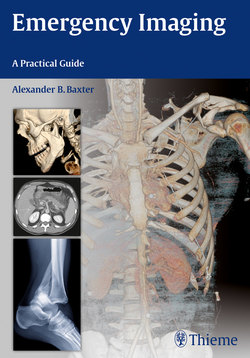Читать книгу Emergency Imaging - Alexander B. Baxter - Страница 93
На сайте Литреса книга снята с продажи.
Оглавление79
2Brain
acute neurologic abnormalities, particu-larly seizures. Primary glial tumors, which arise deep to the cortex, are usually much larger than metastases when they become symptomatic.
On nonenhanced CT, metastases may be iso- or hypodense to adjacent brain and are usually revealed by their surround-ing vasogenic edema rather than the mass itself. Metastases are typically hyperin-tense on T2 and FLAIR MRI and will usu-ally enhance following CT or MR contrast administration. Some are characteristi-cally hemorrhagic: choriocarcinoma, thy-roid carcinoma, melanoma, and renal cell carcinoma. These should be considered in patients with unexplained parenchymal hemorrhage, particularly at the gray-white junction. The mnemonic CT-MR (chorio-carcinoma, thyroid carcinoma, melanoma, renal cell carcinoma) can aid in their recol-lection. Lung and breast carcinoma metas-tases should be considered as well, because even though they are less likely to bleed, they are far more common (Fig. 2.34).
◆Cerebral Metastasis
Brain metastases are common in advanced malignancy and are most frequently seen in patients with lung cancer, breast cancer, melanoma, renal cell carcinoma, or gastro-intestinal adenocarcinoma. Patients often present with subacute headache, seizure, or focal neurologic impairment.
Most cerebral metastases are blood-borne, and their pattern of distribution is a consequence of regional intracerebral blood flow. Approximately 80% are found in the cerebrum, most often in the middle cerebral artery territory; 15% occur in the cerebellum, and 5% in the brainstem. Lep-tomeningeal metastases involve the sur-face of the brain and spinal cord and are the result of cortical or meningeal seeding.
Brain metastases are usually well de-marcated with pronounced surround-ing vasogenic edema. Enhancing nodules are usually less than 2 cm in diameter and located in the subcortical and corti-cal parenchyma near the gray-white mat-ter junction. Because of their juxtacortical location, even small metastases can cause
Fig. 2.34a–fa–d Parenchymal metastases from lung carcinoma. (a,b) 2-cm left frontal cortical mass with marked associated vasogenic edema. A second focus of edema involves the right frontal operculum. Minimal left-to-right subfalcine shift. The brain is otherwise normal. (c,d) T2 and FLAIR images show corresponding extensive vasogenic edema.
e,f Leptomeningeal metastases from lung carcinoma. Multiple small nodules and focal linear cortical enhancement on postcontrast CT.
